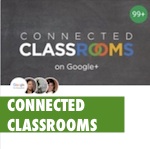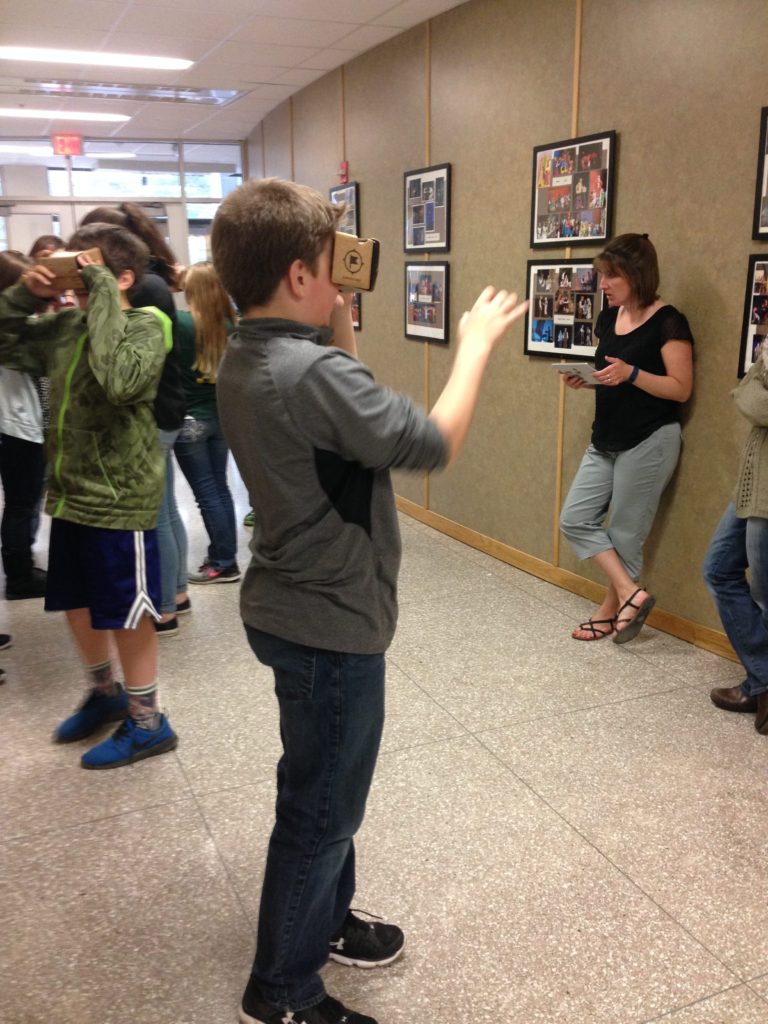Too many ‘awesomes’ to count.
 That was a note I took while experiencing students’ reactions to Google Expeditions at Lamoille Union Middle/High School this week. Audible collective “wows” along with “this is awesome” “I feel like I’m flying, that’s why I’m scared” “I love this” permeated the air as students put the cardboard devices to their faces and entered a virtual world. As the Google representative described it to one class, “buckle up your magic school bus seat belts for a virtual reality tour of National Parks and the world’s seven wonders.”
That was a note I took while experiencing students’ reactions to Google Expeditions at Lamoille Union Middle/High School this week. Audible collective “wows” along with “this is awesome” “I feel like I’m flying, that’s why I’m scared” “I love this” permeated the air as students put the cardboard devices to their faces and entered a virtual world. As the Google representative described it to one class, “buckle up your magic school bus seat belts for a virtual reality tour of National Parks and the world’s seven wonders.”
What are Google Expeditions?

If you are unfamiliar with Google Cardboard and the Expeditions pilot, Tim Moynihan’s description in the Wired Magazine article Google is Bringing its VR Field Trips to Even More Schools quickly gets at the heart of it:
“Using cheap cardboard headsets, Android phones, and a teacher-operated tablet, Google Expeditions lets students experience 360-degree views of places like Machu Picchu, outer space, and caves in Slovakia. Students are free to explore the immersive environments independently, but using a tablet screen as a guided tour interface, teachers can point out important things in each scene, add notes to the VR experience, and see an overlay that shows them where each student is looking.”
Colchester MS Ss totally engaged on virtual field trip to Mayan RuinsThank u #googleexpeditions 4 coming to #vted pic.twitter.com/dBQuztW6u7
— Lucie deLaBruere (@techsavvygirl) May 3, 2016
One student at Lamoille described the virtual reality experience this way:
“It’s kind of like you’re inside of where you are, like a slide show but you are in a room where the TV is all the way around you and someone is just talking while you are looking around at things.”
Here you can see Lamoille Union middle schoolers exploring the 7 New Wonders of the World led by their teacher Cori Rockwood, who helped them navigate the space using a tablet and dashboard supplied by Google.
Many of these Lamoille students do have experience with visiting panoramic spaces using Google Earth or 360 Cities, so viewing a site via panoramic views is not new to them. Given this prior experience, I assumed participating in Google Expeditions would feel similar in terms of a lived experience, but the whole group response of sustained delight surprised me. Take a listen to how these two students describe this unique experience:
Virtual reality and empathy?
The question arises about how to use virtual reality in schools to move from novel engagement to deep learning. In the New York Times article A Virtual Reality Revolution, Coming to a Headset Near You, Lorne Manly suggests:
“The theory behind this sort of immersive journalism, as its become known in academic and journalistic circles, is that the visceral nature of the experience makes a viewer a new kind of witness.”
While the middle school students were taking tours of famous locations, high school students in another class were visiting a Syrian refugee camp and wondering how they might design more humane living situations to meet their needs.
Other sources are developing virtual reality interactive video experiences aimed at eliciting an emotionally charged response. the NY Times VR short videos viewed through Google Cardboard situate the viewer in a refugee camp during a food drop or on the dark somber streets of Paris during a vigil. These virtual experiences add an affective dimension to understanding others’ experiences that is difficult to capture via texts or 2D images in quite the same way.
To learn more about virtual reality and empathy building, take a look at Chris Milk’s TEDTalk: How Virtual Reality Can Create the Ultimate Empathy Machine. You can explore a number of these immersive video experiences here: the Discovery Channel App, Vrse, NY Times VR, RYOT.
How to get involved
Even if you missed participating in this round, you have an opportunity to join the fun by gaining access to the Expeditions App – participate in beta by applying to gain access to the Expedition app using this form.
Explore other opportunities to invite students to explore worlds outside the walls of your classroom:


Comments are closed.